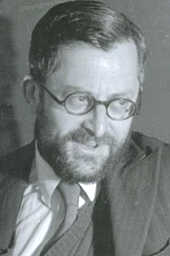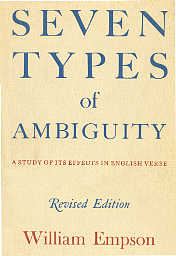Sleeping Beauties in my prose —
I'll have none of those.
Give me ones who
spring to liveliness
Without the need of
slobbery kiss.
Let not one stay unawake
till I my terminal period make.
Please pay respect to my acuity
if you find an unintended ambiguity —
It is apt to happen, now and then,
that one should split in twain and twin.
The ambiguities in the next stanza by Browning are rife, and yet resolve into a beautiful song
before the terminal period.
I want to know a butcher paints,
A baker rhymes for his pursuit,
Candlestick-maker, much acquaints
His souls with song, or, haply mute,
Blows out his brains upon the flute.
If I might offer a paraphrase, given that the only similarity of myself to Robert Browning is our common given name, it would be this:
My dear friend if you would suicide commit,
And fain would not relent in your pursuit,
Find yourself a song that to your mood would fit,
And, forsooth, blow your brains out with a flute.
One of the more offensive conversational ploys to come into recent popularity is making verbal
quotes with two fingers of two raised hands. One wonders if such people could communicate with
their hands tied behind their backs. In written text, the habit of quotes or italics around one word for
emphasis is equally egregious. One may use such artifacts until one learns to write in such a way that
they are not needed, rather as one soon learns to walk as a child without leaning upon nearby objects.
[page 28] And that is why the practice of putting single words into italics for emphasis (again the Victorians are guilty) is so vulgar; a well-constructed sentence should be able to carry a stress on any of its words and should show in itself how these stresses are to be compounded. Both in prose and poetry, it is the impression that implications of this sort have been handled with more judgment that you yourself realise, that with this language as text innumerable further meanings, which you don’t know, could be deduced, that forces you to feel respect for a style.
If I might hazard to re-code Empson’s florid style into one flower of meaning: you feel a respect for the style of an author whose crafty combination of stresses and text (process and content) hints of meanings beyond those that you yourself might be able to evoke with the same economy of expression.
It is easy to be confused by the prolix of spelling and punctuation which fill Shakespeare's plays.
Empson points out that our confusion is merely a consequence of having frozen the forms of words
and punctuation since then. One does better to consider the leeway which we can have when reading
Shakespeare. ". . . the Elizabethan rules of punctuation trusted to the reader's intelligence and were
more interested in rhetoric than in grammar." (Page 134)
[page 83, 84] One must consider . . . that the Elizabethans minded very little
about spelling and punctuation; that this must have given them an attitude to
the written page entirely different from our (the reader must continually have
been left to grope for the right word); that from the comparative slowness, of
reading as of speaking, that this entailed, he was prepared to assimilate
words with a completeness which is now lost; that only our snobbish oddity of
spelling imposes on us the notion that one mechanical word, to be snapped up
by the eyes, must have been intended; and that it is Shakespeare's normal
method to use a newish, apparently irrelevant word, which spreads the
attention thus attracted over a wide map of the ways in which it may be
justified.
Can you spot the pattern in Othello's words, "the flinty and steel couch of war"? We have a noun
and noun of noun, a flinty couch and a steel couch of war or taken together "the flint and steel with
which you fire your gun." (Page 90) Or in this one from Hamlet (page 91), "Even to the teeth and
forehead of our faults." Or this one from Measure for Measure, "Whether it be the fault and glimpse
of newness" (Page 92). Or this one of the form "by noun and noun, the noun": "As when, by night and
negligence, the fire is spied". There is a good reason this usage seems familiar.
[page 94] . . . Shakespeare uses it very often; it has been drummed,
therefore, into the ears of his reader till they take it for granted.
Within the book and volume of my brain.
Upon the heat and flame of thy distemper.
The flash and outbreak of a fiery mind.
The pales and forts of reason.
The slings and arrows of outrageous fortune.
The whips and scorns of time.
The natural gates and alleys of the body.
After reading all these examples of the form, I could not resist incorporating the form into a poem
I was writing for an annual event in which my club members invite their ladies to a formal dinner at
Antoine's Restaurant in the French Quarter and read poems to them.
In this year and night of mirth we come here
To feast and fete you ladies with our song.
Let us lift our Spirit and our Task to Thee
Whose voices and shapes to Heav'n belong —
While we Earth-bound, and bound to worship Thee,
Loose our tongue and spirit with our melody.
What could stay our chorus on this night
But a look and sigh of Love from Thee
Upon my fellow romantics and me.
Hold but a minute and a smile aright
And we will hold our glasses high to Thee
To toast the Love that you have shown to them and me.
This next poem by Pope about old women, seems to me most true about women of the country
club set for whom beauty is the be all and end all of their otherwise empty lives. It is droll to imagine
the ghosts of beauty haunting the wrinkles where formerly beauty lived. They marry the convivial
young stud lubricated by martinis who grows into an alcoholic slug.
[page 149] As hags hold sabbats, not for joy but spite,
So these their merry miserable night;
So round and round the ghosts of beauty glide,
And haunt the places where their honor died.
See how the world its veterans rewards.
Fair to no purpose, artful to no end,
Young without lovers, old without a friend;
A fop her passion, and her prize a sot;
Alive ridiculous, and dead forgot.
Empson suggests that it was the study of Hebrew, especially the Old Testament, and the English
versions of the Bible that helped create our tolerance and even penchant for ambiguity.
[page 193] The study of Hebrew, by the way, and the existence of English
Bibles with alternatives in the margin, may have had influence on the capacity
of English for ambiguity; Donne, Herbert, Jonson, and Crashaw, for instance,
were Hebrew scholars, and the flowering of poetry at the end of the sixteenth
century corresponded with the first thorough permeation of the English
language by the translated texts. This is of interest because Hebrew, having
very unreliable tenses, extraordinary idioms, and a strong taste for puns,
possesses all the poetical advantages of a thorough primitive disorder.
With Egyptian hieroglyphics, we find the seventh type of ambiguity most strongly, the one in which
the two meanings of a word can be opposite to one another. One word could mean both young and
old, with only a gesture in spoken language available to distinguish the baby from the old man. In
writing, a hieroglyph could be present to indicate which is meant and to trigger the extra hieroglyph
when required.
Here we are, having survived the seven types of ambiguity and still possessing a working sense
of humor, we hope. We have learned a bit about ambiguity and how it brings a liveliness and freshness
to poetry. Contrary to our modern "belts and suspenders of meaning", we have discovered the freedom of Elizabethan poetry which required neither a belt of
exact spelling nor any suspenders of grammatical punctuation,
hanging instead upon the page and awaiting our pleasure for the
dressing or undressing of its meaning. To paraphrase my favorite poet,
Samuel Hoffenstein, "Lives there a man with hide so tough, who thinks seven types of ambiguity are
not enough?"





